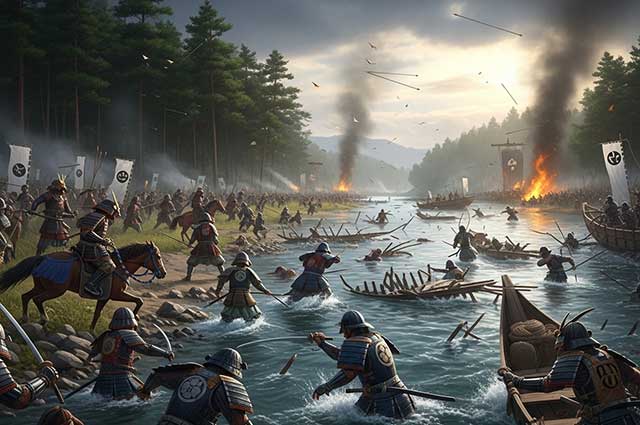
In 1556, the Shimazu clan launched a campaign aimed at systematically conquering the island of Kyushu. In the same year, the province of Osumi was annexed and a war began with the Ito clan for control of the province of Hyuga. In 1577, Ito Yoshisuke was defeated and fled north, where he sought help from Otomo Sorin, the Christian daimyo of Bungo Province.
Otomo Sorin immediately invaded Hyuga Province. His army of about 50,000 soldiers, commanded by Tawara Tikataka, Sorin's half-brother, began the siege of Taka Castle. The castle was of strategic importance in the region, as it allowed control over vast territories of the province. After the defeat of the Ito clan, Yamada Arinobu was appointed commander of the castle, with a garrison of about 1,500 men under his command. Despite numerous attacks, the defenders of the castle managed to repel them, and Otomo's troops were forced to resort to a passive siege.
When Shimazu Yoshihisa learned that Taka Castle was under siege, he gathered an army and marched towards Sadowara. His brother, Shimazu Yoshihiro, took a different route. On the way, he encountered the vanguard of Otomo's troops, attacked it, and completely scattered it. Building on their success, Yoshihiro's men destroyed the fortified fort on Mount Matsuyama, after which they joined forces with the main forces of the Shimazu clan.
Yoshihisa placed most of his troops in ambush near Taka Castle. A small detachment attacked the besieging Otomo forces and pretended to retreat. Pursuing them, the Otomo soldiers crossed the Takajo River and were ambushed. At the same moment, the garrison of Taka Castle made a sortie and attacked the enemy from the rear. Otomo's troops were defeated and fled.
The Shimazu army pursued them to the Mimigawa River, about 20 kilometers north of Taka Castle, where they completed their defeat of the enemy. This battle went down in history as the “Battle of Mimigawa,” although it would be more accurate to call it the “Battle of Takajo River.” After this victory, the Shimazu established control over the entire province of Hyuga.
See also
-
The Siege of Hara Castle

The Shimabara Rebellion of 1637–1638, which culminated in the siege of Hara Castle, was the last major uprising of the Edo period and had serious political consequences.
-
Battle of Tennoji

The confrontation between Tokugawa Ieyasu and Toyotomi Hideyori during the “Osaka Winter Campaign” ended with the signing of a peace treaty. On January 22, 1615, the day after the treaty was signed, Ieyasu pretended to disband his army. In reality, this meant that the Shimazu forces withdrew to the nearest port. On the same day, almost the entire Tokugawa army began filling in the outer moat.
-
Siege of Shuri Castle

The Ryukyu Kingdom was established in 1429 on Okinawa, the largest island of the Ryukyu (Nansei) archipelago, as a result of the military unification of three rival kingdoms. In the following years, the state's control spread to all the islands of the archipelago.
-
The Siege of Fushimi Castle

Fushimi can perhaps be considered one of the most “unfortunate” castles of the Sengoku Jidai period. The original castle was built by Toyotomi Hideyoshi in the southeast of Kyoto in 1594 as his residence in the imperial city.
-
The Siege of Otsu Castle

The siege of Otsu Castle was part of the Sekigahara campaign, during which the so-called Eastern Coalition, led by Tokugawa Ieyasu, fought against the Western Coalition, led by Ishida Mitsunari. Otsu Castle was built in 1586 by order of Toyotomi Hideyoshi near the capital Kyoto, on the site of the dismantled Sakamoto Castle. It belonged to the type of “water castles” — mizujō — as one side of it faced Japan's largest lake, Lake Biwa, and it was surrounded by a system of moats filled with lake water, which made the fortress resemble an island.
-
The Siege of Shiroishi Castle

The siege of Shiroishi Castle was part of the Sekigahara campaign and took place several months before the decisive battle of Sekigahara. The daimyo of Aizu Province, Uesugi Kagekatsu, posed a serious threat to Tokugawa Ieyasu's plans to defeat the Western Coalition, and Ieyasu decided to curb his actions with the help of his northern vassals. To this end, he ordered Date Masamune to invade the province of Aizu and capture Shiroishi Castle.
-
The Second Siege of Jinju Castle

During the two Korean campaigns of the 16th century, the Japanese repeatedly had to capture enemy fortresses and defend occupied or constructed fortifications from the combined Korean and Chinese forces. Among all the operations of that time, the second siege of Jinju Castle is considered the most interesting from the point of view of siege warfare.
-
The Siege of Takamatsu Castle

The siege of Takamatsu Castle in Bitchu Province is considered the first mizuzeme, or “water siege,” in Japanese history. Until then, such an original tactic had never been used.

